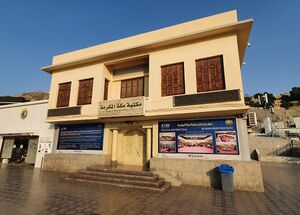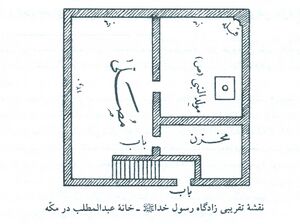Mawlid al-Nabi
 | |
| General Information | |
|---|---|
| Other Names | Makka al-Mukarrma Library |
| Place | Mecca, Shi'b Abi Talib, Suq al-Layl |
| Usage | Mosque |
| History | |
| Time of Construction | 2/8 century |
| Events | Birth of the Prophet(s) |
| Reconstructions | Multiple times |
| Current State | |
| Status | Destroyed, a library is built in its place |
Mawlid al-Nabi (Arabic: مولد النبي) the Prophet's birthplace is the house of 'Abd Allah b. 'Abd al-Muttalib, where the Prophet Muhammad(s) was born. This place was located in Mecca in the neighborhood of Shi'b Abi Talib. In the second/eighth century, Khayzaran, the mother of Harun al-Rashid, bought the place and turned it into a mosque. Reports from the 6th/12th century onwards indicate that an ornate marble monument for marking the birthplace of the Prophet(s) was built in a part of the mosque. In the reconstruction of 1009/1600-1, a large dome and minaret were built for this mosque.
The Mawlid al-Nabi Mosque was considered one of the blessed places in Mecca, and every year on the night of the birth of the Prophet(s), the people of Mecca attended there. Sources from the 10th/16th century report a special and official ritual that was held on the eve of the 12th of Rabi' I with the presence of the Ottoman governor of Mecca).
Due to the importance and fame of Mawlid al-Nabi, the building has been rebuilt many times by order of kings and nobles, but it was destroyed during the rule of the House of Saud like many blessed places and buildings in Mecca (in 1343/1924-25). In the year 1370/1950-51 to keep the memory of this place, a library was built in it, which is still there, and it is called Makka al-Mukarrma Library.
History
The house where the Prophet Muhammad(s) was born, was located in Shi'b Abi Talib in a neighborhood called Suq al-Layl. It was called "Mawlid al-Nabi" or the Prophet's birthplace. In some historical sources, other places have been mentioned as the possible places of the Prophet's birth, which is not approved by most historians of Mecca.[1]
Until the Third/Ninth Century
According to al-Azraqi in his book Akhbar Makka, who lived in the third/ninth century, Mawlid al-Nabi, or the house where the Prophet(s) was born, fell into the hands of 'Aqil, son of Abu Talib, after Hijra, and was passed on to 'Aqil's children until it was sold to Muhammad b. Yusuf al-Thaqafi added it to his house known as the White House. When Khayzran, the mother of Harun al-Rashid, performed hajj in 171/788, she bought it and built a mosque in it. Al-Azraqi states that the people of Mecca have no discord about the Prophet's birthplace.[2] The same report was also given by al-Fakihi (245/859-60), another historian of Mecca.[3]
Ibn Jubayr's Report (Seventh/Thirteenth Century)
Ibn Jubayr (614/1217-18) visited the mosque in 579/1184 and described it in his travelogue.[4] He describes the building to be a magnificent mosque that "opens on Mondays in the month of Rabi' I, which is the month of the Prophet's birth, and people will come there on that day to obtain grace and blessings, and other holy places will also be opened on the same day."[5]
According to Ibn Jubayr, the Prophet's birthplace in this mosque is built in the form of a small pond with a width of three spans, in the middle of which is a green marble with a width of two-thirds of a span, covered in silver. The mihrab of the mosque is located in front of this place.[6]
Al-Fasi's Report (Ninth/Fifteenth Century)
More than two centuries later, the Mecca historian Taqi al-Din al-Fasi (832/1428-29) described this place, which was respected and cherished by the people of Mecca, in the book Shifa' al-gharam. The building of the mosque is depicted as a square shape with two vaults, which have a large khanqah in its southwest corner.[7]
Evliya Çelebi's Report (Eleventh/Seventeenth Century)
Two and a half centuries later, in 1081/1670-71, the Turkish traveler Evliya Çelebi saw Mawlid al-Nabi(s) and described it in his book. He described this building as a large and beautiful mosque, which was a square building with a high dome covered with lead. Çelebi mentioned the decorations inside the mosque, including the precious carpet and the pulpit covered with silk cloth and a gilded door. According to him, the Prophet's birthplace was a stone in a yellow hole on which the place of his body was imprinted.[8]
Last Descriptions Before Destruction
Mulla Ibrahim Kaziruni, who had the opportunity to visit this house in 1315/1898, writes: "On Friday, the 14th, we went to visit the Prophet(s) birthplace located in Suq al-Layl. We went inside and went down approximately fourteen steps. We entered a room which is the mosque. After that, we went to another room. There is a darih in this room. The servant opened the door of darih. There is a pit inside in the middle of it a green stone, which was the birthplace of the Prophet(s)."[9]

Muhammad Labib al-Batanuni who traveled to Mecca in 1327/1909 drew the plan of Mawlid al-Nabi in his travelogue and described it as follows: "When you enter it, you first enter a 12x6 square meters hall. On the right wall, there is a door, after passing through it you will enter a space over which a dome is placed, in the middle of the space and under the dome leaning against the western wall, there is a wooden darih inside which is a concave marble stone marking the birthplace of the Prophet(s)."[10]
Renovations
The building of Mawlid al-Nabi was the attention of princes and kings and was renovated many times. The list of these renovations is as follows:
- 576/1180-81, By al-Naser, the 'Abbasid Caliph;
- 666/1267-68, King al-Muzaffar, the ruler of Yemen;
- 740/1339-40, King al-Mujahid, the ruler of Yemen;
- 758/1357, Amir Shaykhun, a nobleman from Egypt;
- 766/1364-65, King Sha'ban, King of Egypt;
- 801/1398-99, King al-Zahir Barquq, King of Egypt;[11]
In the Ottoman Era
- In 935/1528-29, King Sulayman;
- In 1009/1600-1, by the order of King Muhammad under the supervision of Ghadanfar Agha[12] In this reconstruction, a large dome and a minaret were built for this building, endowments were assigned for it, and a mu'azzin, a servant, and an imam for congregational prayer were assigned for the mosque by the Ottoman government.[13]
- In 1230/1850, Muhammad 'Ali Pasha of Egypt by the order of King Muhammad Khan.
- The last repair is said to have been in the time of 'Abd al-Majid Khan.[14]
Prophet's Birthday Celebration in Mawlid al-Nabi Mosque
In the 6th/12th century, Ibn Jubayr reported the gathering of the people of Mecca in the Mawlid al-Nabi Mosque on Monday in the month of Rabi' I to celebrate the Prophet's birthday.[15] There are reports of the celebration of the birth of the Prophet in this place in later centuries.
Muhammad b. Ahmad al-Nahrawali (d. 990/1582) gave a detailed report about the ritual of the Prophet's birthday in the 10th/16th century. According to him, every year on the eve of Rabi' I 12, after Maghrib prayer, the jurists, nobles, grandees, and people, while carrying candles and torches, gather before the supervisor of al-Masjid al-Haram and the judges of four Sunni denominations, and from al-Masjid al-Haram to Suq al-Layl and Mawlid al-Nabi place and enter it and gather near the birthplace of the Prophet(s). A sermon is read there, and after that, people come to al-Masjid al-Haram, and some officials of al-Masjid al-Haram are given robes, and the 'Isha' prayer is held, and the ceremony ends.[16]More than a century later, a travel writer who went on Hajj in 1105-1106 AH narrated the same report of Nahrawali and described this event as a big gathering in which many bedouins and residents of other cities participated.[17]

Destruction and Construction of the Library
In the House of Sa'ud rule, the building of Mawlid al-Nabi, like many old buildings in Mecca, was destroyed in the year 1343/1924-25 under the pretext that people were seeking blessings in it.[18]
Later, because there was no grave to be visited in this place, some people tried to get permission to rebuild it. In 1370/1950-51, permission was issued to build a library in the place.
The construction cost was paid by Fatima, daughter of Yusuf al-Qattan, and her brother Shaykh 'Abbas al-Qattan (d. 1370/1950-51) supervised the construction of the building, and after his death, his sons finished the construction of the building. In this way, the Library of Makkah al-Mukarrma was built in this place.[19]
Notes
- ↑ Fasi al-Makki, Shifa' al-gharam, vol. 1, p. 270.
- ↑ Azraqī, Akhbār Makka, vol. 2, p. 198.
- ↑ Fakihi, Akhbar Makka fi qadim al-dahr wa haithih, vol. 4, p. 5.
- ↑ Jubayr, Safarnāma-yi Ibn Jubayr, p. 82, 125.
- ↑ Jubayr, Safarnāma-yi Ibn Jubayr, p. 154.
- ↑ Jubayr, Safarnāma-yi Ibn Jubayr, p. 126-127.
- ↑ Fasi, Shifa' al-gharam, vol. 1, p. 268.
- ↑ Çelebi, al-Riḥla al-Ḥijāzīyya, pp. 255-256
- ↑ Safarnam-iy Mulla Ibrahim Kaziruni, p. 366.
- ↑ Batanuni , Safarnam-iy hijaz, p. 146.
- ↑ Fasi, Shifa' al-gharam, vol. 1, p. 270.
- ↑ Sanjārī, Manāʾiḥ al-karam, vol. 3, p. 506.
- ↑ Ṭabarī, Tārikh Makka, vol. 2, p. 15.
- ↑ Makkī, Ifādat al-anām, vol. 2, p. 71.
- ↑ Ibn Jubayr, 'Safarnama Ibn Jubayr, p. 154.
- ↑ Nahrawānī, al-Iʿlām bi-aʿlām Bayt Allāh al-harām, p. 422.
- ↑ Nāblusī, Al-Ḥaqīqa wa l-majāz, vol. 3, p. 354-355.
- ↑ Bilādī, Maʿālim Makka, p. 294.
- ↑ Abū Sulaymān, Maktabat Makka al-mukarrama, p. 80.
References
- ʿAbd al-Wahhāb Ibrāhīm Abū Sulaymān. Maktabat Makka al-mukarrama qadīman wa ḥadīthan. Riyadh: Maktaba al-Malik Fahd al-Waṭanīyya, 1433AH.
- Azraqī, Muḥammad b. ʿAbd Allāh al-. Akhbār Makka wa mā jāʾa fī-hā min al-āthār. Edited by Rushdī Ṣāliḥ Mulḥis. Beirut: 1403AH.
- Batanūnī, Muḥammad Labīb al-. Al-Riḥla al-Ḥijāzīyya. Cairo: Al-Thiqāfat al-Dīnīyya, n.d.
- Bilādī, ʿĀtiq al-.Maʿālim Makka al-tārikhīyya wa al-atharīyya. Dār Makka: 1400 AH.
- Çelebi, Evliya. Al-Riḥla al-Ḥijāzīyya. Dār al-Āfāq al-ʿArabīyya, 1420 AH.
- Fāsī al-Makkī, Muḥammad b. Aḥmad al-.Shifāʾ al-gharām bi-akhbār al-balad al-ḥarām. Edited by ʿUmar ʿAbd al-Salām al-Tadmurī. Beirut: Dār al-Kitāb al-ʿArabī, 1405 AH.
- Jubayr, Muḥammad b. Aḥmad. Safarnāma-yi Ibn Jubayr. Translated by Parwīz Atābakī. Mashhad: Intishārāt-i Āstān-i Quds-i Raḍawī, 1370 Sh.
- Makkī,ʿAbd Allāh Ghāzī al-.Ifādat al-anām bi-akhbār Balad Allah al-ḥarām.
- Nāblusī, ʿAbd al-Ghanī al-. Al-Ḥaqīqa wa l-majāz fī raḥlat al-bilād al-Shām wa Misr wa al-Ḥijāz. Damascus: Dār al-Maʿrifa, 1419AH.
- Nahrawālī al-Makkī, Quṭb al-Dīn al-.Al-Iʿlām bi-aʿlām Bayt Allāh al-harām. Cairo: Maktabat al-Thiqāfat al-Dīnīyya, 1425AH.
- Sanjārī, ʿAlī b. Tāj al-Dīn al-. Manāʾiḥ al-karam. Mecca: Umm al-Qurā University, 1998.
- Ṭabarī, Muḥammad b. ʿAlī al-. Tārikh Makka, ittiḥāf fuḍalāʾ al-zaman bi-tārīkh wālī-h banī l-Ḥasan. Cairo: Dār al-Kitāb al-Jāmiʿī, 1413AH.